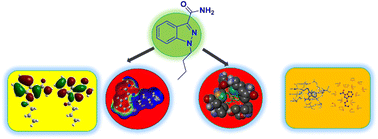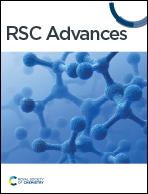Synthesis molecular docking and DFT studies on novel indazole derivatives†
Abstract
The amide bond is an important functional group used in various fields of chemistry, including organic synthesis, drug discovery, polymers, and biology. Although normal amides are planar, and the amide has an N–C(O) bond, herein, the 26 indazole derivatives were reported via amide cross-coupling (8a–8z). Using IR, 1H NMR, 13C NMR, and mass spectrometry, all of the produced compounds were analysed. A DFT computational study was also conducted using GAUSSIAN 09-Gaussian View 6.1, which revealed that 8a, 8c, and 8s had the most substantial HOMO–LUMO energy gap. The effectiveness of indazole moieties with renal cancer-related protein (PDB: 6FEW) was assessed by docking the derivatives using Autodock 4. The analysis showed that derivatives 8v, 8w, and 8y had the highest binding energies.



 Please wait while we load your content...
Please wait while we load your content...